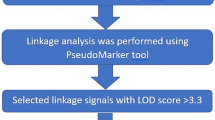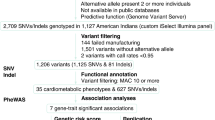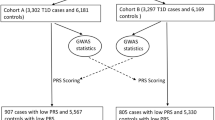Abstract
Protein tyrosine phosphatase non-receptor type 22 (PTPN22) is the third major locus affecting risk of type I diabetes (T1D), after HLA-DR/DQ and INS. The most associated single-nucleotide polymorphism (SNP), rs2476601, has a C->T variant and results in an arginine (R) to tryptophan (W) amino acid change at position 620. To assess whether this, or other specific variants, are responsible for T1D risk, the Type I Diabetes Genetics Consortium analyzed 28 PTPN22 SNPs in 2295 affected sib-pair (ASP) families. Transmission Disequilibrium Test analyses of haplotypes revealed that all three haplotypes with a T allele at rs2476601 were overtransmitted to affected children, and two of these three haplotypes showed statistically significant overtransmission (P=0.003 to P=5.9E-12). Another haplotype had decreased transmission to affected children (P=3.5E-05). All haplotypes containing the rs2476601 T allele were identical for all SNPs across PTPN22 and only varied at centromeric SNPs. When considering rs2476601 ‘C’ founder chromosomes, a second haplotype (AGGGGC) centromeric of PTPN22 in the C1orf178 region was associated with protection from T1D (odds ratio=0.81, P=0.0005). This novel finding requires replication in independent populations. We conclude the major association of PTPN22 with T1D is likely due to the recognized non-synonymous SNP rs2476601 (R620W).
This is a preview of subscription content, access via your institution
Access options
Subscribe to this journal
Receive 6 digital issues and online access to articles
$119.00 per year
only $19.83 per issue
Buy this article
- Purchase on Springer Link
- Instant access to full article PDF
Prices may be subject to local taxes which are calculated during checkout

Similar content being viewed by others
References
Bottini N, Musumeci L, Alonso A, Rahmouni S, Nika K, Rostamkhani M et al. A functional variant of lymphoid tyrosine phosphatase is associated with type I diabetes. Nat Genet 2004; 36: 337–338.
Wellcome Trust Case Control Consortium. Genome-wide association study of 14,000 cases of seven common diseases and 3,000 shared controls. Nature 2007; 447: 661–678.
Cloutier JF, Veillette A . Cooperative inhibition of T-cell antigen receptor signaling by a complex between a kinase and a phosphatase. J Exp Med 1999; 189: 111–121.
Vang T, Congia M, Macis MD, Musumeci L, Orru V, Zavattari P et al. Autoimmune-associated lymphoid tyrosine phosphatase is a gain-of-function variant. Nat Genet 2005; 37: 1317–1319.
Smyth D, Cooper JD, Collins JE, Heward JM, Franklyn JA, Howson JM et al. Replication of an association between the lymphoid tyrosine phosphatase locus (LYP/PTPN22) with type 1 diabetes, and evidence for its role as a general autoimmunity locus. Diabetes 2004; 53: 3020–3023.
Zheng W, She JX . Genetic association between a lymphoid tyrosine phosphatase (PTPN22) and type 1 diabetes. Diabetes 2005; 54: 906–908.
Ladner MB, Bottini, N Valdes AM, Noble JA . Association of the single nucleotide polymorphism C1858T of the PTPN22 gene with type 1 diabetes. Hum Immunol 2005; 66: 60–64.
Qu H, Tessier MC, Hudson TJ, Polychronakos C . Confirmation of the association of the R620W polymorphism in the protein tyrosine phosphatase PTPN22 with type 1 diabetes in a family based study. J Med Genet 2005; 42: 266–270.
Steck AK, Liu SY, McFann K, Barriga KJ, Babu SR, Eisenbarth GS et al. Association of the PTPN22/LYP gene with type 1 diabetes. Pediatr Diabetes 2006; 7: 274–278.
Onengut-Gumuscu S, Buckner JH, Concannon P . A haplotype-based analysis of the PTPN22 locus in type 1 diabetes. Diabetes 2006; 55: 2883–2889.
Zoledziewska M, Perra C, Orru V, Moi L, Frongia P, Congia M et al. Further evidence of a primary, causal association of the PTPN22 620W variant with type 1 diabetes. Diabetes 2008; 57: 229–234.
Velaga MR, Wilson V, Jennings CE, Owen CJ, Herington S, Donaldson PT et al. The codon 620 tryptophan allele of the lymphoid tyrosine phosphatase (LYP) gene is a major determinant of Graves’ disease. J Clin Endocrinol Metab 2004; 89: 5862–5865.
Begovich AB, Carlton VE, Honigberg LA, Schrodi SJ, Chokkalingam AP, Alexander HC et al. A missense single-nucleotide polymorphism in a gene encoding a protein tyrosine phosphatase (PTPN22) is associated with rheumatoid arthritis. Am J Hum Genet 2004; 75: 330–337.
Kyogoku C, Langefeld CD, Ortmann WA, Lee A, Selby S, Carlton VE et al. Genetic association of the R620W polymorphism of protein tyrosine phosphatase PTPN22 with human SLE. Am J Hum Genet 2004; 75: 504–507.
Hermann R, Lipponen K, Kiviniemi M, Kakko T, Veijola R, Simell O et al. Lymphoid tyrosine phosphatase (LYP/PTPN22) Arg620Trp variant regulates insulin autoimmunity and progression to type 1 diabetes. Diabetologia 2006; 49: 1198–1208.
Chelala C, Duchatelet S, Joffret ML, Bergholdt R, Dubois-LaForgue D, Ghandil P et al. PTPN22 R620W functional variant in type 1 diabetes and autoimmunity related traits. Diabetes 2007; 56: 522–526.
Kawasaki E, Awata T, Ikegami H, Kobayashi T, Maruyama T, Nakanishi K et al. Systematic search for single nucleotide polymorphisms in a lymphoid tyrosine phosphatase gene (PTPN22): association between a promoter polymorphism and type 1 diabetes in Asian populations. Am J Med Genet 2006; 140: 586–593.
Smyth DJ, Cooper JD, Howson JM, Walker NM, Plagnol V, Stevens H et al. PTPN22 Trp620 explains the association of chromosome 1p13 with type 1 diabetes and shows a statistical interaction with HLA class II genotypes. Diabetes 2008; 57: 1730–1737.
Rieck M, Arechiga A, Onengut-Gumuscu S, Greenbaum C, Concannon P, Buckner JH . Genetic variation in PTPN22 corresponds to altered function of T and B lymphocytes. J Immunol 2007; 179: 4704–4710.
Aarnisalo J, Treszl A, Svec P, Marttila J, Oling V, Simell O et al. Reduced CD4(+)T cell activation in children with type 1 diabetes carrying the PTPN22/Lyp 620Trp variant. J Autoimmun 2008; 31: 13–21.
Criswell LA, Pfeiffer KA, Lum RF, Gonzales B, Novitzke J, Kern M et al. Analysis of families in the multiple autoimmune disease genetics consortium (MADGC) collection: the PTPN22 620W allele associates with multiple autoimmune phenotypes. Am J Hum Genet 2005; 76: 561–571.
Brown WM, Pierce JJ, Hilner JE, Perdue LH, Lohman K, Lu L et al. and the Type I Diabetes Genetics Consortium. Overview of the Rapid Response data. Genes Immun 2009; 10(Suppl 1): S5–S15
Coultas L, Pellegrini M, Visvader JE, Lindeman GJ, Chen L, Adams JM et al. Bfk: a novel weakly proapoptotic member of the Bcl-2 protein family with a BH3 and a BH2 region. Cell Death Differ 2003; 10: 185–192.
Barrett JC, Fry B, Maller J, Daly MJ . Haploview: analysis and visualization of LD and haplotype maps. Bioinformatics 2005; 21: 263–265.
Abecasis GR, Cherny SS, Cookson WO, Cardon LR . Merlin--rapid analysis of dense genetic maps using sparse gene flow trees. Nat Genet 2002; 30: 97–101.
Thomson G . Mapping disease genes: family-based association studies. Am J Hum Genet 1995; 57: 487–498.
Acknowledgements
This research uses resources provided by the Type I Diabetes Genetics Consortium, a collaborative clinical study sponsored by the National Institute of Diabetes and Digestive and Kidney Diseases (NIDDK), National Institute of Allergy and Infectious Diseases (NIAID), National Human Genome Research Institute (NHGRI), National Institute of Child Health and Human Development (NICHD), and Juvenile Diabetes Research Foundation International (JDRF) and supported by U01 DK062418. Genotyping was performed at the Broad Institute Center for Genotyping and Analysis is supported by grant U54 RR020278 from the National Center for Research Resources. BOB was support by the German Research Foundation (DFG: SFB 518 & GrK 1041).
Author information
Authors and Affiliations
Consortia
Corresponding author
Rights and permissions
About this article
Cite this article
Steck, A., Baschal, E., Jasinski, J. et al. rs2476601 T allele (R620W) defines high-risk PTPN22 type I diabetes-associated haplotypes with preliminary evidence for an additional protective haplotype. Genes Immun 10 (Suppl 1), S21–S26 (2009). https://doi.org/10.1038/gene.2009.87
Published:
Issue Date:
DOI: https://doi.org/10.1038/gene.2009.87
Keywords
This article is cited by
-
Single-cell expression and Mendelian randomization analyses identify blood genes associated with lifespan and chronic diseases
Communications Biology (2020)
-
The Past, Present, and Future of Genetic Associations in Type 1 Diabetes
Current Diabetes Reports (2011)
-
Overview of the Type I Diabetes Genetics Consortium
Genes & Immunity (2009)
-
Analysis of 19 genes for association with type I diabetes in the Type I Diabetes Genetics Consortium families
Genes & Immunity (2009)
-
The Type I Diabetes Genetics Consortium ‘Rapid Response’ family-based candidate gene study: strategy, genes selection, and main outcome
Genes & Immunity (2009)



